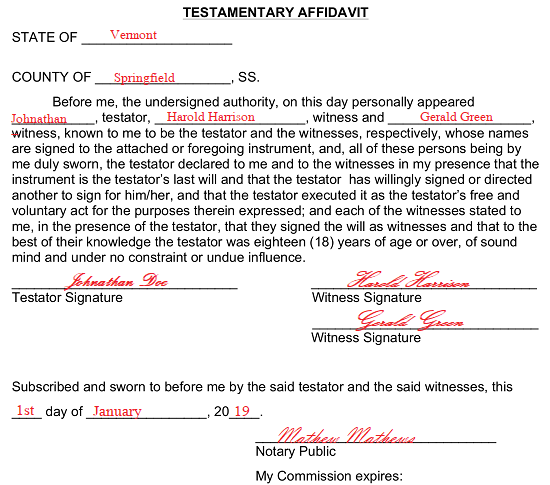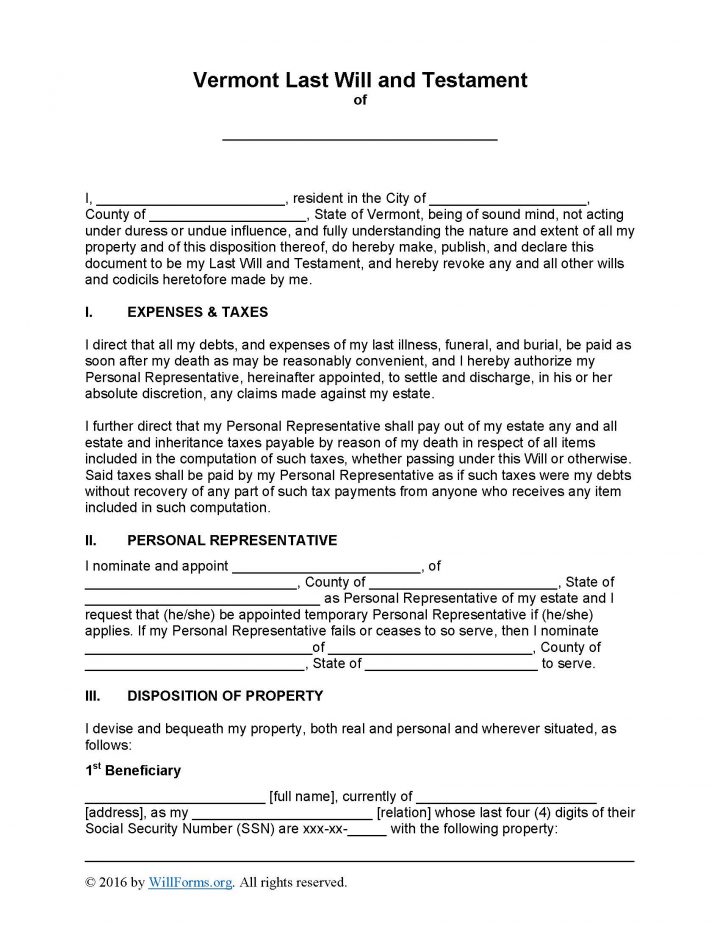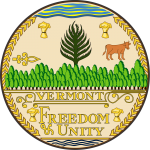
|
Vermont Last Will and Testament Form |
Vermont Last Will and Testament Form is set to be the paperwork you will need to fill out and issue once you have determined what should happen to your tangible and intangible property upon your death. Since this is a standardized document, containing all the wording required for its purpose under Vermont Statutes (Title 14: Decedents Estates And Fiduciary Relations), you will be able to simply record what your final intentions are as well as update it easily should your property status and assets become subject to change. This can be an invaluable tool especially, since any discrepancies may cause undo confusion during a difficult time for loved ones.
Laws – Title 14 §1, et seq.
How to Write
1 – Save The Living Will Provided On this Page To Your Machine
The file on this page is accessible as a PDF or Word using the buttons present near the preview window.
2 – Supply The Beginning Of This Declaration With Your Identity
The title of this document will need your direct input to be completed. When you are ready to begin, enter your full name on the blank line it contains. 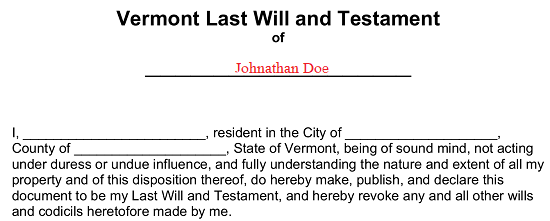
3 – Name Your Personal Representative And The Disposition
The first paragraph of this page begins with a request for your name. Present it on the first blank line displayed. 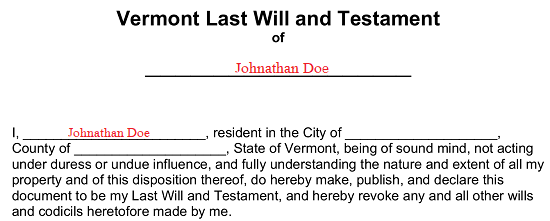 Continue through the paragraph until the words “City Of” then input the city of your residential address followed by the county of your residence across the next two available spaces.
Continue through the paragraph until the words “City Of” then input the city of your residential address followed by the county of your residence across the next two available spaces. 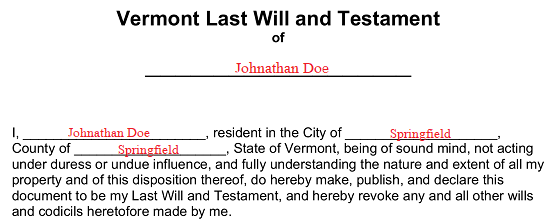 The second article, “II. Personal Representative,” will require you to formally elect someone to this role. The first blank line in this section will need the full name of the person you wish to handle your estate and any bequeathment you wish to occur. This process of identification will need your report on his or her home street address as well as his or her county and state of residence.
The second article, “II. Personal Representative,” will require you to formally elect someone to this role. The first blank line in this section will need the full name of the person you wish to handle your estate and any bequeathment you wish to occur. This process of identification will need your report on his or her home street address as well as his or her county and state of residence.  In some cases, your initial choice for the Personal Representative may not be able to function in this role, is unavailable, or will not function in this aspect when the time comes for him or her to live up to the responsibility. Therefore, it is recommended that you set up an Alternate Personal Representative. To do so, locate the term “…Then I Nominate,” and document this alternate Personal Representative’s entire name and full residential address using the first line that follows for his or her name and the last three lines as a presentation for this individual’s street address, county, and city.
In some cases, your initial choice for the Personal Representative may not be able to function in this role, is unavailable, or will not function in this aspect when the time comes for him or her to live up to the responsibility. Therefore, it is recommended that you set up an Alternate Personal Representative. To do so, locate the term “…Then I Nominate,” and document this alternate Personal Representative’s entire name and full residential address using the first line that follows for his or her name and the last three lines as a presentation for this individual’s street address, county, and city. 
4 – Supplement The Language In The Beneficiary Statements To Define The Inheritance
Now, it will be time to set to paper how you wish your property to be handled or dispensed. This will be done through a basic declaration that will need some information to supplement its wording. This information will be your direct wishes. Begin by identifying the first individual you would like to give property. The Recipient of your possessions (tangible or intangible) is known as a Beneficiary and should be identified on the first blank line in the “1st Beneficiary” paragraph. 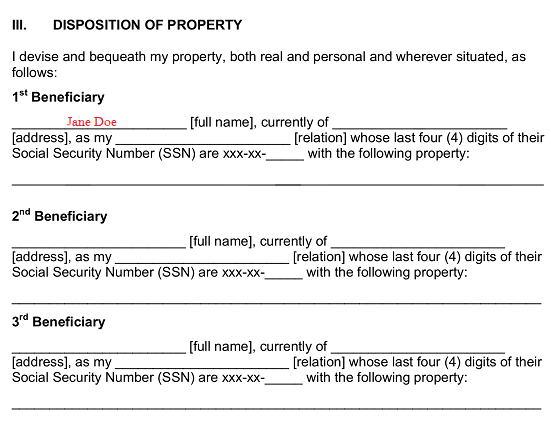 The individual you have named as your 1st Beneficiary must be further defined through his or her address. This address should be presented exactly as it appears on his or her federal or state level I.D. Produce his or her address on the space after the term “…Currently Of” and preceding the label “[Address].”
The individual you have named as your 1st Beneficiary must be further defined through his or her address. This address should be presented exactly as it appears on his or her federal or state level I.D. Produce his or her address on the space after the term “…Currently Of” and preceding the label “[Address].” 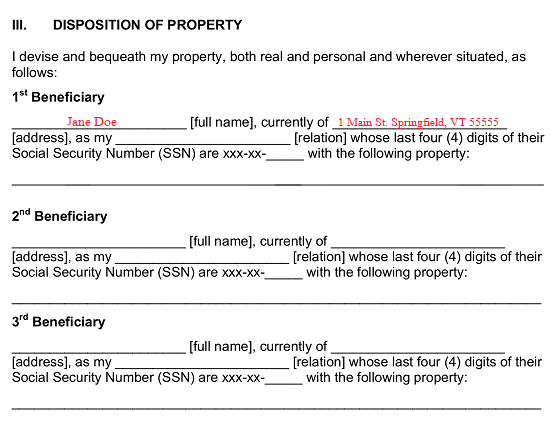 Additionally, report how you know your First Beneficiary on the space attached to the bracketed label “[Relation].”
Additionally, report how you know your First Beneficiary on the space attached to the bracketed label “[Relation].” 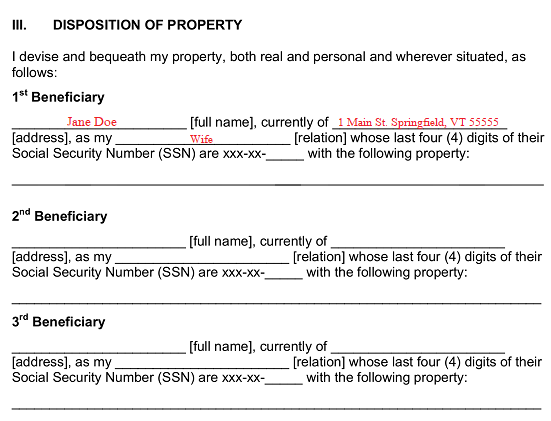 You must present the last four digits of his or her social security number on the space following the wording “Social Security Number (SSN) Are XXX-XX”
You must present the last four digits of his or her social security number on the space following the wording “Social Security Number (SSN) Are XXX-XX”  The final blank space of the First Beneficiary paragraph will need an account of what property and assets are being left to him or her.
The final blank space of the First Beneficiary paragraph will need an account of what property and assets are being left to him or her. 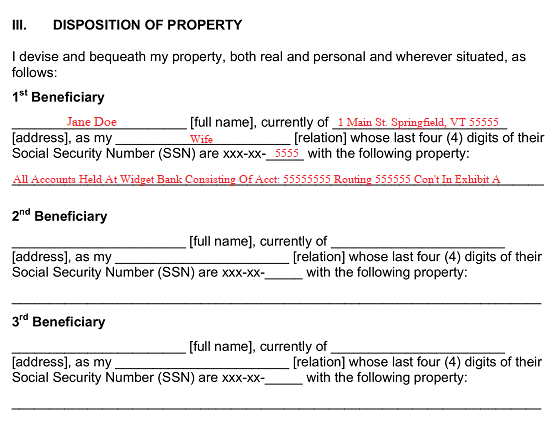 The “2nd Beneficiary” and “3rd Beneficiary” paragraphs will function in the same way as the one above, you may bequeath your belongings to as many Beneficiaries as you wish but each one must be identified with the exact same wording. If you require additional paragraphs, you may copy and paste more (and title them accordingly) into a separate document then attach it to this one before the time of signing or you may simply paste them directly into this document after the “3rd Beneficiary” paragraph. Do not delete any text to make room since the remainder of this template will deliver important powers, limitations, and instructions pertaining to the parties involved above.
The “2nd Beneficiary” and “3rd Beneficiary” paragraphs will function in the same way as the one above, you may bequeath your belongings to as many Beneficiaries as you wish but each one must be identified with the exact same wording. If you require additional paragraphs, you may copy and paste more (and title them accordingly) into a separate document then attach it to this one before the time of signing or you may simply paste them directly into this document after the “3rd Beneficiary” paragraph. Do not delete any text to make room since the remainder of this template will deliver important powers, limitations, and instructions pertaining to the parties involved above. 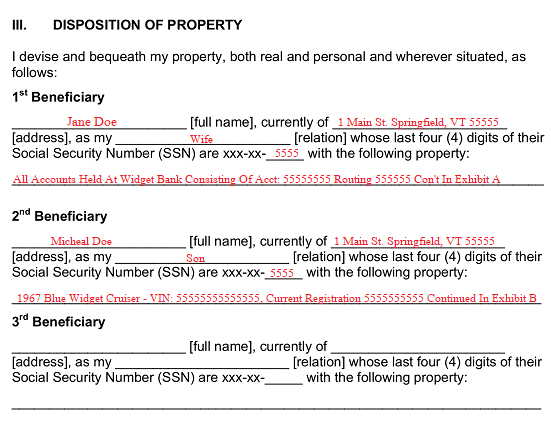
5 – Finalize Your Wishes Before Two Witnesses And A Notary Public
The twelfth article, “Binding Arrangement,” will be an additional testimonial that is expected to conclude this paperwork before executing it to effectiveness. Only two items will be needed here, the first of which is the full name of the individual who is drafting and executing this paperwork to bequeath his or her possessions to the appropriate individuals upon death. Enter your name on the blank space following the words “I, The Undersigned…” Complete this paragraph with the exact date of signature. This will be the date when this document is officially active and may be carried out should you pass away. Enter this date across the last three blank lines in a format presenting the two-digit day, month, and year. 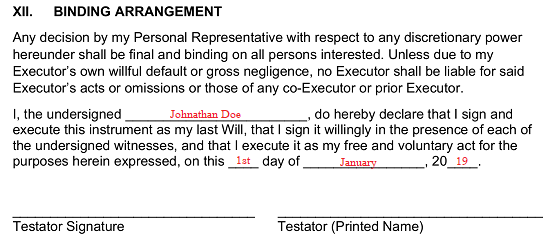 You, as the Testator, must sign this document and produce your printed name exactly as it was recorded earlier in this document. It is recommended you read through the completed paperwork before signing your name on the blank line labeled “Testator Signature” then printing your name on the line “Testator (Printed Name)”
You, as the Testator, must sign this document and produce your printed name exactly as it was recorded earlier in this document. It is recommended you read through the completed paperwork before signing your name on the blank line labeled “Testator Signature” then printing your name on the line “Testator (Printed Name)” 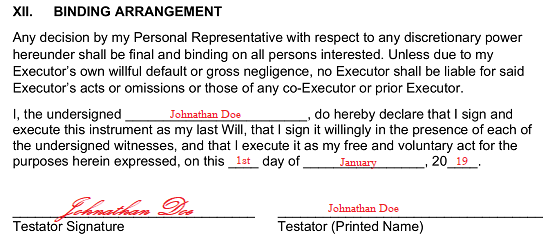 Your act of signing this document must be verifiable in the future as an action that has occurred under the proper circumstances. To this end, two Witnesses and a Notary Public must agree to view you performing the signature. When you have finished signing this document pass it to the Witnesses present. The testimonial below your signature area will need the current date recorded using the first three blank lines and the full name of the Signature Party (You) printed after the words “…Thereof By.” If this paragraph is completed and both Witnesses agree with it, then each one must sign one of the lines designated with the label “Witness Signature” then document his or her “Address” on the corresponding line.
Your act of signing this document must be verifiable in the future as an action that has occurred under the proper circumstances. To this end, two Witnesses and a Notary Public must agree to view you performing the signature. When you have finished signing this document pass it to the Witnesses present. The testimonial below your signature area will need the current date recorded using the first three blank lines and the full name of the Signature Party (You) printed after the words “…Thereof By.” If this paragraph is completed and both Witnesses agree with it, then each one must sign one of the lines designated with the label “Witness Signature” then document his or her “Address” on the corresponding line. 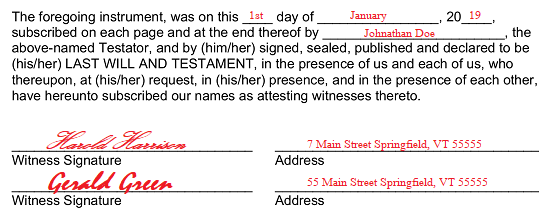 Once both Witnesses have signed this document as verification of the Testator signing, it must be passed on to the Notary Public in attendance so that he may report the circumstances of signing and provide his or her credentials in its support.
Once both Witnesses have signed this document as verification of the Testator signing, it must be passed on to the Notary Public in attendance so that he may report the circumstances of signing and provide his or her credentials in its support. 